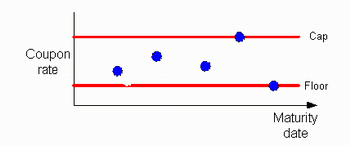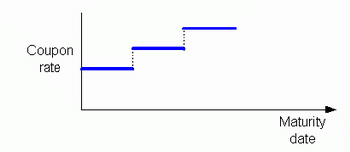- CFA Exams
- 2026 Level I
- Topic 6. Fixed Income
- Learning Module 2. Fixed-Income Cash Flows and Types
- Subject 1. Fixed-Income Cash Flow Structures
Seeing is believing!
Before you order, simply sign up for a free user account and in seconds you'll be experiencing the best in CFA exam preparation.
Subject 1. Fixed-Income Cash Flow Structures PDF Download
Principal Repayment Structures
Bullet bond. The issuer pays the full principal amount at the maturity date.
Amortizing bond. Its payment schedule requires periodic payment of interest and repayment of principal. If the entire principal is not amortized over the life of the bond, a balloon payment is required at the end of the term.
A sinking fund arrangement allows a bond's principal outstanding amount to be repaid each year throughout the bond's life or after a specific date.
A call provision is the right of the issuer to retire the issue prior to the stated maturity date. When only part of an issue is called, the bond certificates to be called are selected randomly or on a pro rata basis.
Coupon Payment Structures
The coupon payments of a floating rate security are reset periodically (e.g., quarterly) according to a reference rate such as LIBOR.
Example
Suppose that the reference rate is the 1-month LIBOR and the quoted margin is 100 basis points: if the 1-month LIBOR on the coupon reset rate is 5%, the coupon rate is 5% + 100 basis points = 6%.
The quoted margin does not need to be a positive value. For example, it could be -90 basis points.
A floating-rate security may have upper and/or lower limits on the coupon rate. A cap is the maximum coupon rate of a floater. It is an attractive feature for the issuer since it limits the coupon rate. A floor is the minimum coupon rate, and it is an attractive feature for the investor. A collar is a floater with both a cap and floor.

For example, assume the reference rate is the 1-month LIBOR, the quoted margin is 100 basis points, and there is a cap of 7%. If the 1-month LIBOR at reset date was 6.5%, the coupon rate per the formula would be 7.5% (6.5% + 1%), but with the cap the coupon rate is restricted to 7%.
A typical floater's coupon rate increases when the reference rate increases and decreases when the reference rate decreases. However, an inverse floater's (also called a reverse floater) coupon rate moves in the opposite direction from the change in the reference rate: coupon rate = K - L x reference rate, where K and L are constant values set forth in the prospectus for the issue. To prevent a negative coupon rate there is a floor imposed.
For example, an inverse floater's coupon rate = 12% - 2 x 3-month LIBOR. If the three-month LIBOR is 2%, then the coupon rate for the next interest payment period is: 12% - 2 x 2% = 8%.
Step-up coupon bonds have low initial and gradually increasing coupon rates; that is, their coupon rates "step up" over time.

Stepped spread floaters. The quoted margins for these coupons can step to either a higher or a lower level over the security's life. For example, a five-year floating-rate note's coupon rate may be six-month LIBOR + 1% for the first two years, and three-month LIBOR + 3% for the remaining years.
Credit-linked coupon bonds. These coupons change when the issuer's credit rating changes.
Payment-in-kind coupon bonds. These coupons allow the issuer to pay coupons with additional amounts of the bond issue rather than in cash.
The payment structures for index-linked bonds vary considerably among countries. An inflation-linked bond or linker links its coupon payments and/or principal repayments to a price index. For example, the Treasury Inflation Protection Securities' (TIPS) coupon is based on inflation rate: coupon rate = rate of inflation + quoted margin. The index can even be a stock market index.
User Contributed Comments 22
| User | Comment |
|---|---|
| kalps | Drop lock bond - the coupon is automatically changed from a floating to a fixed rate under vertain circumstances |
| yxten1 | HOW ON EARTH AM I SUPPOSE TO REMEMBER EACH AND EVERY SINGLE FEATURE OF THE BOND!!!!! |
| soltari007 | i hear you man. |
| Bremen | We are on the same boat... SUCK IT UP dude... =) |
| viksam | Why are "Non-interest rate indexes" grouped under "adjustable quoted margin"? These bonds seem to have a fixed margin. |
| NavdeepS | not really viksam, for example TIPS may float as they indexed to inflation readings |
| mwali | I wonder how a person can master this and all the other stuff. This is tough |
| srhyland | Under what circumstance would a Range bond make sense? |
| ciji | Q.Which bond gives you a coupon of zero zero seven ? A. James Bond. |
| Tosh4nt | Kangaroo bond....lol...refer to Wikipedia |
| zubayer | i think i am going to be your new partner in this mission. i'm majoring on finance in Dhaka university. but i'm really willing to let you know that i'm getting these topics quite easy! |
| humzakhan | All this is making me leave a Matured Deleveraged floater in my pants :S |
| Jilany | Ratchet Bond - The issuer can reset the coupon annually to a lower rate after an initial fixed rate period. The holder may put the bond to issuer, but only if the coupon has been reset to a lower level. |
| Leonie | I don't think they will ask to many questions on the different types of bonds. Or I hope not!! |
| gulfa99 | @sryland: You may invest in range bonds when you expect the interest rates to remain range bond for foreseeable future. |
| johntan1979 | If reference rate for range notes falls outside of the range, coupon rate is zero. Doesn't that mean that there is no quoted margin? So why is range notes classified under "constant quoted margin"? |
| johntan1979 | And same question as viksam, which NavdeepS failed to address: TIPS float because they are indexed to inflation rates but that's the reference rate that is adjustable. What about the quoted margin? That seems fixed. |
| johntan1979 | I guess the answer to my question about range notes is, 0 is the constant for range notes' quoted margin. |
| jonan203 | the name of the bond gives you a huge clue as to the structure of its coupon. |
| gill15 | DIRTS NERDD with t being for TIPS....thats all of them....this nerd is not smart so he`s got two D`s... Not that it matters though....I doubt the question will ask you which ones are reference rates.. |
| Shaan23 | I'm used Gills anagram to memorize. Breezed thru it. |
| dirdeb | what does DIRTS NERDD stand for? |

I passed! I did not get a chance to tell you before the exam - but your site was excellent. I will definitely take it next year for Level II.

Tamara Schultz
My Own Flashcard
No flashcard found. Add a private flashcard for the subject.
Add